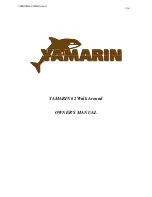
2-15
130 Super Sport
Section 2 • General Information
R
Belaying Knot
Fig. 2.15.1
From
Boat
From
Boat
(make loop and
rotate before pulling
over the horn)
(pull tight to
complete the
belaying knot)
!
CAUTION
Long term lifting with the bow and stern
eyes or with the bow locker eyelet can cause
stress on the
fi berglass and gel coat and is not
recommended.
Whether you are lifting your boat out of the water for
routine maintenance or long term storage, consider
the following:
•
If you are using a professional lifting
service, it is prudent to check all
credentials and ask for proof of insurance
to protect your investment.
•
Use a wide, fl at, belted sling for lifting, to
minimize stress on the gunwales. Careful
location of the sling is required. DO NOT
PLACE SLINGS WHERE UNDER
WATER FITTINGS WILL BE IN
CONTACT.
Lifting
•
If using a lifting hook, attach to bow eye
and the stern lifting eyes mounted on the
transom. Always usea spreader bar on the
stern eyes and use chafi ng protection on the
top ofthe transom.
•
All drain plugs (i.e. transom, fi shwell,
deck, etc.) should be pulled out and the
boat positioned with the bow slightly
higher than the stern so that any water
which is allowed to accumulate in the
cockpit and/or bilge can easily drain from
the boat.
Trailering
The 130 Super Sport has a trailer which is best suited
for length and width of the boat. If you have a trailer
or plan on purchasing a trailer separately, there are
some points you need to consider, such as:
• Having a center roller and keel guards will
help provide good support for the keel, also
provide good fore and aft support.
• Trailers equipped with rollers instead of
bunks can damage the foam sandwich hull of
your boat and should never be used.
• Bunks provide a more even weight
distribution.
Your warranty may be void if you use a trailer
with rollers. Use a trailer with bunks ONLY
NOTICE
It is your responsibility to trailer correctly. Each
state has different requirements. Check with
your state agency for the specifi c requirements
for trailering in your state.
NOTICE
You will have to experiment to determine which
towing method will work best for your specifi c
requirements. In some cases, a single tow line will
be suffi cient. Other cases may require a bridle
from the transom of the larger vessel or a double
bridle going back to the bow eye to reduce yawing.
You will have to experiment with the tow line to
achieve the boats best ride behind the wake. It is
wise to attach a separate security line from the
bridle or tow line to the interior cleat. This line
should be loose and not take any strain from the
tow. This will act as a shock preventer should
the bow eye fail or the towing bridle connections
let go. Although the bow eye is reinforced, high
speed towing in rough water conditions should be
avoided as constant heavy jerking could loosen the
bow eye.
Towing
















































